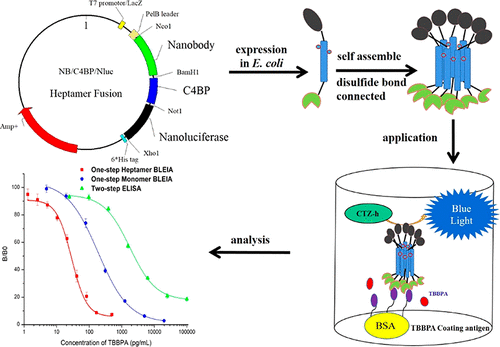当前位置:
X-MOL 学术
›
Anal. Chem.
›
论文详情
Our official English website, www.x-mol.net, welcomes your
feedback! (Note: you will need to create a separate account there.)
An Ultrasensitive Bioluminescent Enzyme Immunoassay Based on Nanobody/Nanoluciferase Heptamer Fusion for the Detection of Tetrabromobisphenol A in Sediment.
Analytical Chemistry ( IF 6.7 ) Pub Date : 2020-06-19 , DOI: 10.1021/acs.analchem.0c01908 Zhenfeng Li 1 , Yi Wang 1, 2 , Natalia Vasylieva 1 , Debin Wan 1 , Zihan Yin 1 , Jiexian Dong 3 , Bruce D Hammock 1
Analytical Chemistry ( IF 6.7 ) Pub Date : 2020-06-19 , DOI: 10.1021/acs.analchem.0c01908 Zhenfeng Li 1 , Yi Wang 1, 2 , Natalia Vasylieva 1 , Debin Wan 1 , Zihan Yin 1 , Jiexian Dong 3 , Bruce D Hammock 1
Affiliation

|
Tetrabromobisphenol A (TBBPA) is a flame retardant and has become a widely concerning environmental pollutant. An ultrasensitive nanobody-based immunoassay was developed to monitor the exposure of TBBPA in sediment. First, the anti-TBBPA nanobody was fused with nanoluciferase, and then a one-step bioluminescent enzyme immunoassay (BLEIA) was developed with high sensitivity for TBBPA, with a maximum half inhibition concentration (IC50) at 187 pg/mL. Although approximately 10-fold higher sensitivity can be achieved by this developed BLEIA than by the classical two-step ELISA (IC50 at 1778 pg/mL), it is still a challenge to detect trace TBBPA in sediment samples reliably due to the relatively high matrix effect. To further improve the performance of this one-step BLEIA, a C4b-binding protein (C4BP) was inserted as a self-assembling linker between the nanobody and nanoluciferase. Therefore, a heptamer fusion containing seven binders and seven tracers was generated. This reagent improved the binding capacity and signal amplification. The one-step heptamer plus BLEIA based on this immune-reagent shows an additional 7-fold improvement of sensitivity, with the IC50 of 28.9 pg/mL and the limit of detection as low as 2.5 pg/mL. The proposed assay was further applied to determine the trace TBBPA in sediment, and the recovery was within 92–103%. Taking advantage of this heptamer fusion, one-step BLEIA can serve as a powerful tool for fast detection of trace TBBPA in the sediment samples.
中文翻译:

基于纳米抗体/纳米荧光素酶七聚体融合的超灵敏生物发光酶免疫法检测沉积物中的四溴双酚A。
四溴双酚A(TBBPA)是一种阻燃剂,已经成为广泛关注的环境污染物。开发了一种基于纳米抗体的超灵敏免疫测定法,以监测沉积物中TBBPA的暴露。首先,将抗TBBPA纳米抗体与纳米荧光素酶融合,然后开发出对TBBPA具有高灵敏度的一步生物发光酶免疫分析(BLEIA),最大半抑制浓度(IC 50)为187 pg / mL。尽管通过这种发达的BLEIA可获得的灵敏度比经典的两步ELISA约高10倍(IC 50浓度为1778 pg / mL),由于基质效应相对较高,要可靠地检测沉积物样品中的痕量TBBPA仍然是一项挑战。为了进一步改善这一一步BLEIA的性能,将C4b结合蛋白(C4BP)插入为纳米抗体和纳米荧光素酶之间的自组装连接子。因此,产生了包含七个结合剂和七个示踪剂的七聚体融合体。该试剂改善了结合能力和信号放大。基于该免疫试剂的一步法七聚体加上BLEIA,IC 50使灵敏度进一步提高了7倍。检出限为28.9 pg / mL,检出限低至2.5 pg / mL。拟议的测定法进一步应用于确定沉积物中痕量的TBBPA,回收率在92–103%之内。利用这种七聚体融合技术,一步式BLEIA可以用作快速检测沉积物样品中痕量TBBPA的强大工具。
更新日期:2020-07-21
中文翻译:

基于纳米抗体/纳米荧光素酶七聚体融合的超灵敏生物发光酶免疫法检测沉积物中的四溴双酚A。
四溴双酚A(TBBPA)是一种阻燃剂,已经成为广泛关注的环境污染物。开发了一种基于纳米抗体的超灵敏免疫测定法,以监测沉积物中TBBPA的暴露。首先,将抗TBBPA纳米抗体与纳米荧光素酶融合,然后开发出对TBBPA具有高灵敏度的一步生物发光酶免疫分析(BLEIA),最大半抑制浓度(IC 50)为187 pg / mL。尽管通过这种发达的BLEIA可获得的灵敏度比经典的两步ELISA约高10倍(IC 50浓度为1778 pg / mL),由于基质效应相对较高,要可靠地检测沉积物样品中的痕量TBBPA仍然是一项挑战。为了进一步改善这一一步BLEIA的性能,将C4b结合蛋白(C4BP)插入为纳米抗体和纳米荧光素酶之间的自组装连接子。因此,产生了包含七个结合剂和七个示踪剂的七聚体融合体。该试剂改善了结合能力和信号放大。基于该免疫试剂的一步法七聚体加上BLEIA,IC 50使灵敏度进一步提高了7倍。检出限为28.9 pg / mL,检出限低至2.5 pg / mL。拟议的测定法进一步应用于确定沉积物中痕量的TBBPA,回收率在92–103%之内。利用这种七聚体融合技术,一步式BLEIA可以用作快速检测沉积物样品中痕量TBBPA的强大工具。











































 京公网安备 11010802027423号
京公网安备 11010802027423号